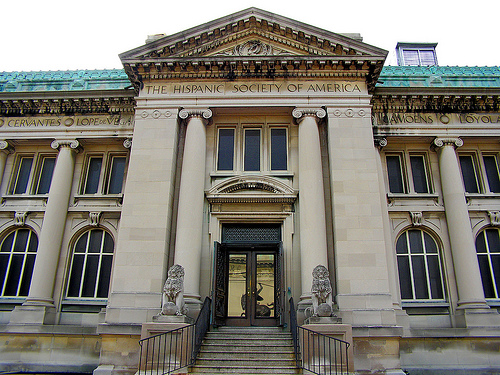Very few people are aware of the small, yet beautiful, museum dedicated to the art of Spain and other Spanish speaking countries located in the lower Washington Heights neighborhood of Manhattan. The Hispanic Society of America houses a museum and library that are never too crowded as well as a terrace filled with beautiful sculptures. This gem is not only for hispanic culture enthusiasts, but it is also a must-see for anybody who appreciates fine arts. Displayed artwork includes artifacts, sculptures, paintings and even mosaics from the ancient Roman Empire. The museum boasts a diverse collection of artwork from a variety of periods including Medieval, Spanish Baroque, Impressionist, and Contemporary art represented by artists from Spain and Latin America. The large, open gallery situated toward the entrance of the museum, is actually a cloister with a glass ceiling which fills the gallery with natural light, adding to the beauty of the artwork.
On the first floor, one can enjoy medieval art representing religious scenes with well preserved and ornate altar pieces. One of the altar pieces is an elaborate work dedicated to two saints, St. John the Baptist and St. John the Evangelist, who are portrayed in the central panel. They stand symmetrically with identical poses, creating a certain rhythm to the work. The left side displays various scenes from the life of St. John the Baptist. For example, a cruel depiction of his beheading can be found in the upper left corner as Salamay dances, flaunting St. John the Baptist’s disfigured head on a plate. The Flemish influence on Spanish artists becomes apparent in this work, an interesting similarity to the altar pieces found in the Cloisters Museum, just a few miles uptown. Also, as part of the medieval collection, a visitor can see the marble tomb sculptures of various Spanish nobles that also have figures of the Virgin Mary dating as far back as the 13th century. On the first floor, I found the 18th-century sculpture of St. Michael killing the dragon especially fascinating due to its doll-like representation, vivid colors and elaborate costume, considered modern for that time period. Overall, the sculpture is vibrant with movement and color that is common in Spanish-influenced, Latin American art.
The most prized artworks of the collection, representing a comprehensive history of Spanish art, can be found on the second floor. The plethora of masterpieces by famous Spanish artists housed in the small museum demands a gasp from their audience. When I entered this gallery, I encountered the works of one of the most popular Spanish artists of the sixteenth century, Luis de Morales, nicknamed “the Divine” because of the religious themes in his subject matter. For instance, in his painting Ecce Homo, or Behold the Man, the rich colors of the contemporary Roman clothing on Pontius Pilate are juxtaposed with the pale color of Christ’s scourged skin.
As I proceeded through the gallery, the distinct silvers, blues, reds and greens as well as the elongated figures in the paintings of El Greco immediately caught my eye. With unusual lighting, El Greco creates a spacious perspective. One of his most renowned works is St. Jerome. Saint Jerome, a well-known scholar, philosopher, and translator of the Bible into Latin, is depicted as the religious hermit he was. The book symbolizes his wisdom and knowledge while the ominous skull and hourglass remind viewers of life and mortality. In addition, he holds a cross in his devotion to Jesus Christ. His chest is exposed, portraying his self-imposed punishment as he beats his chest with rocks for indulging in secular learning.
The peak of the Spanish Golden Age of Art is well represented by the works of Diego Velázquez. He was of great significance as a court painter for King Philip IV and created many portraits of Spanish nobility with great historical and cultural significance. In his portrait of Don Gaspar de Guzmán, the Count-Duke of Olivares stands tall in an all black powerful costume with gilded details and a red velvet background, symbolizing his wealth and important status. The simplicity of the background complements the imposing figure without distracting from the subject.
In addition, the collection presents works by the most influential artist of the Golden era, Francisco Goya. Unfortunately, as of now, some of the best works by this artist such as the Duchess of Alba in Mourning Clothes and other portraits are not on display at this time because they are traveling to London and then to Spain for an exhibition of Goya’s portraits because the Hispanic Society is planning two years of renovations by the end of this year.
The most modern works are in the side gallery on the first floor which offers a panoramic display called the Vision of Spain, a true glimpse into Spanish culture. The fourteen large panels represent nine regions of Spain and everyday Spanish life. The panels are filled with sun and energy with drawings of fruit vendors, bullfighters and fisherman among other common figures.
Visiting the Hispanic Society of America is a pleasant and eye-opening experience. Admission is free for everyone on Tuesdays through Sundays, so if you are ever in the neighborhood of Columbia University, do not miss this museum on 155th Street and Broadway. Also, because it will be closing for two years of renovations, it is important to visit sometime this year.
Lena Yannella
staff writer

